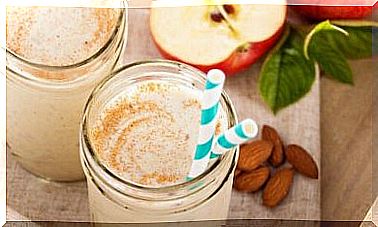Which Is Healthier: Hot Or Cold Food?

Which is healthier: hot or cold food? This question arises when we need to switch from the delicious hot soups of autumn to the cold dishes of the summer or vice versa. However, the myths surrounding the subject confuse us. Therefore, we want to cover it in detail in this article.
Hot food helps to digest food
Do you know why it is advisable to eat or drink something hot even in summer? The answer is very simple: hot foods and liquids favor digestion. This is stated in an article published in the Journal of the Science of Food and Agriculture.
In order for the stomach and intestines to function well, they should be at the same body temperature. This equates to approximately 37 degrees.
Therefore, it seems logical to think that eating hot or lukewarm foods facilitates the digestion process. That way, the stomach doesn’t have to make any extra effort to reach the right temperature before starting work.
Therefore, eating hot foods seems to be a good option for people who suffer from digestive problems or slow digestion. Also, as with spicy foods, hot food is also a good way to get warm.
Temperature increases the absorption of some nutrients

Another thing to keep in mind when choosing between hot and cold food is how temperature affects the nutrients in food. In some cases, the temperature can favor the accessibility and absorption of some nutrients. For this reason, it is interesting to cook certain foods before consuming them:
- Raw eggs make it difficult to digest proteins.
- Cooked tomatoes and carrots increase the availability of their antioxidant components, such as lycopene and beta-carotene.
- Cooked broccoli improves the action of glucosinolates.
Nutrient loss
Contrary to what has been seen before, at other times cooking food can lead to a significant loss of nutrients. This is especially true with water-soluble vitamins such as vitamin C and vitamin B complex, which are very sensitive to heat.
The main source of these vitamins in our diet is fruits and vegetables, which can be eaten raw without any problem. Therefore, it is advisable to include salads and fresh fruits in our daily routine.
We have already seen that if we accompany a cold dish with a second hot food or drink, the stomach will also be able to reach the ideal temperature to function. If it’s difficult for us to eat foods that are too cold, we can take them out of the fridge a little earlier to make them a little warmer.
In the case of vegetables that cannot be eaten raw, the best option is to steam, cook in the oven or in a quick stew. Just the minimum time for them to stay al dente.
Hot or cold food to prevent poisoning

Food safety is also important when preparing meals, which is when we can take the greatest risks. With good control of cooking temperatures, we can avoid many health problems that could become relevant.
Bacterial growth is directly related to temperature. By applying heat, we can eliminate most pathogens. Therefore, it is recommended to cook very well the most sensitive foods (meat, eggs and fish).
Likewise, we must make sure that no portion of the food is raw or undercooked. Once cooked, we should consume them in the shortest time possible or keep them above 65 degrees. If we want to eat them cold, it is important to maintain proper standards of cooking and refrigerated storage.
Hot food tastes better
We perceive the taste of food on the tongue thanks to the taste buds. Food temperature between 20 and 37 degrees favors flavor perception. Also, sometimes, when food is heated, its flavor intensifies and its texture becomes softer.
On the contrary, when we eat very cold food, we have to leave it a little in the mouth to better appreciate its flavor. However, we must be careful with very hot foods.
On the one hand, we tend to reject them to avoid burning our tongues, and on the other hand, the continuous ingestion of very hot foods can favor the appearance of problems in the esophagus and stomach, according to a study published in the journal “ Medicine ”.
As indicated by the Agencia de Investigación del Cáncer , “very hot beverages (above 65 degrees) are classified as possible carcinogens.” This conclusion emerged after reviewing nearly 1,000 studies investigating drinking hot beverages and their possible connection to cancer.
Although we may think that the taste of foods will not make them more or less healthy options, it is very important to know how to taste food. In addition to the amounts, nutrients or absorption, the food also has a lot to do with emotions and well-being.
Chewing slowly and enjoying every bite will turn our hot or cold food into an act of pleasure and joy. And this, while it may not seem relevant, is also a good bet for health.
Which is the best option: hot or cold food?
From all the advantages and disadvantages of hot or cold foods, we can elaborate the following keys to make a better choice:
- Combine hot and cold dishes with every meal, throughout the year.
- Steam, roast or stir-fry vegetables for a short time to minimize vitamin loss and improve nutrient availability.
- Cook meat, fish and eggs well and eat them right after preparing or heating them.
- We must cook certain foods so that their nutrients can be better absorbed. That doesn’t mean we can’t eat them cold.
- Always respect ideal storage conditions and remember that warm or hot foods tend to taste better.









